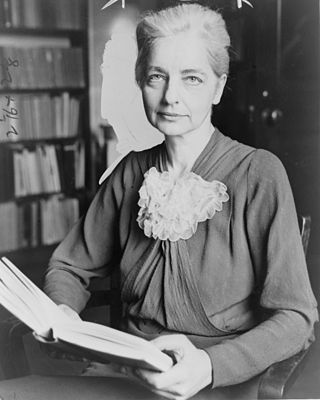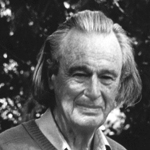
Margaret Mead was an American cultural anthropologist who featured frequently as an author and speaker in the mass media during the 1960s and the 1970s.

Ruth Fulton Benedict was an American anthropologist and folklorist.

Gregory Bateson was an English anthropologist, social scientist, linguist, visual anthropologist, semiotician, and cyberneticist whose work intersected that of many other fields. His writings include Steps to an Ecology of Mind (1972) and Mind and Nature (1979).

Manus Island is part of Manus Province in northern Papua New Guinea and is the largest of the Admiralty Islands. It is the fifth-largest island in Papua New Guinea, with an area of 2,100 km2 (810 sq mi), measuring around 100 km × 30 km. Manus Island is covered in rugged jungles which can be broadly described as lowland tropical rain forest. The highest point on Manus Island is Mt. Dremsel, 718 metres (2,356 ft) above sea level at the centre of the south coast. Manus Island is volcanic in origin and probably broke through the ocean's surface in the late Miocene, 8 to 10 million years ago. The substrate of the island is either directly volcanic or from uplifted coral limestone.

Coming of Age in Samoa: A Psychological Study of Primitive Youth for Western Civilisation is a 1928 book by American anthropologist Margaret Mead based upon her research and study of youth – primarily adolescent girls – on the island of Taʻū in American Samoa. The book details the sexual life of teenagers in Samoan society in the early 20th century, and theorizes that culture has a leading influence on psychosexual development.
The Manus languages are a subgroup of about two dozen Oceanic languages located on Manus Island and nearby offshore islands in Manus Province of Papua New Guinea. The exact number of languages is difficult to determine because they form a dialect continuum. The name Manus originally designated an ethnic group whose members spoke closely related languages and whose coastal dwellers tended to build their houses on stilts out over the sea.

Rambutyo Island is one of the Admiralty Islands in the Bismarck Archipelago. Politically, Rambutyo Island is part of Manus Province, Papua New Guinea. The population (unknown) is concentrated on the west coast. Villages include Mouklen and Lengkau.
Rhoda Bubendy Métraux was a prominent anthropologist in the area of cross-cultural studies. She collaborated with Alfred Métraux on mutual studies of Haitian voodoo. She also studied the Iatmul people of the middle Sepik River in Papua New Guinea and made three fieldwork trips to Tambunum village of 6-7 months each in 1967-1968, 1971, and 1972-1973 that focused on music. During one of her studies, Métraux administered the Lowenfeld Mosaic Test in Tambunum, developed by a Margaret Lowenfeld. Additionally, Métraux did fieldwork in Mexico, Argentina, and Montserrat in the West Indies and enrolled at Yale University to study for her doctorate under the tutelage of Bronisław Malinowski. During World War II, Métraux headed the section on German morale for the US Office of Strategic Services (OSS).
Chambri are an ethnic group in the Chambri Lakes region in the East Sepik province of Papua New Guinea. The social structures of Chambri society have often been a subject in the study of gender roles. They speak the Chambri language.

William Orman Beeman is an American scholar whose specialty is the Middle East. He is Professor Emeritus of anthropology at the University of Minnesota, where he was Chair of the Department of Anthropology for 13 years until his retirement in 2020. He has authored many articles and fourteen books on Iranian politics, theatre, language, and culture.

Neo-Theosophy is a term, originally derogatory, used by the followers of Helena Blavatsky to denominate the system of Theosophical ideas expounded by Annie Besant and Charles Webster Leadbeater following the death of Madame Blavatsky in 1891. This material differed in major respects from Blavatsky's original presentation, but it is accepted as genuinely Theosophical by many Theosophists around the world.

John Derek Freeman was a New Zealand anthropologist known for his criticism of Margaret Mead's work on Samoan society, as described in her 1928 ethnography Coming of Age in Samoa. His attack "ignited controversy of a scale, visibility, and ferocity never before seen in anthropology."
Donald F. Tuzin was an American social anthropologist best known for his ethnographic work on the Ilahita Arapesh, a horticultural people living in northeast lowland New Guinea, and for comparative studies of gender and sexuality within Melanesia. Tuzin was born in Chicago, Illinois, grew up in Winona, Minnesota, and spent his teen years again in Chicago. He received his B.A. from Western Reserve University in Ohio, where he became interested in anthropology and participated in the excavation of Native American archaeological sites left by the Mound Builders. He also received his master's degree from Case Western Reserve.

A Rap on Race is a 1971 non-fiction book co-authored by the writer and social critic James Baldwin and the anthropologist Margaret Mead. It consists of transcripts of conversations held between the pair in August 1970.

Reo Franklin Fortune was a New Zealand-born social anthropologist. Originally trained as a psychologist, Fortune was a student of some of the major theorists of British and American social anthropology including Alfred Cort Haddon, Bronislaw Malinowski and Alfred Radcliffe-Brown. He lived an international life, holding various academic and government positions: in China, at Lingnan University from 1937 to 1939; in Toledo, Ohio, USA from 1940 to 1941; at the University of Toronto, from 1941 to 1943; in Burma, as government anthropologist, from 1946 to 1947; and finally, at Cambridge University in the United Kingdom from 1947 to 1971, as lecturer in social anthropology specialising in Melanesian language and culture.
Mailu Island is a small, 1.8 km long, island in Central Province, Papua New Guinea. It lies 250 km ESE from Port Moresby.
Masalai are a type of supernatural spirit in Papua New Guinea.
Lola Romanucci-Ross was an American cultural anthropologist who has authored and co-authored a number of works on medical, social, and cultural anthropology, with fieldwork in Melanesia (Manus), rural Mexico, and her mother's home town in Italy. She was a long-time friend and collaborator of Margaret Mead, having done fieldwork with her in Manus, and later worked with her then-husband Theodore Schwartz on a team of social science researchers under the guidance of Erich Fromm in rural Mexico.
Baptist Mission Australia, formerly Global Interaction, the Australian Baptist Missionary Society, and originally the Australian Baptist Foreign Mission, is a Christian missionary society founded by Baptists in Australia in 1864. The national office is in Melbourne.
Cannabis in Equatorial Guinea is illegal with severe penalties for the production, sale, and possession of marijuana for medicinal or recreational purposes. Despite the illegality, smoking marijuana remains culturally popular among all strata of society, and it was reported in 2000 that no one has been arrested for smoking or dealing cannabis in living memory.










